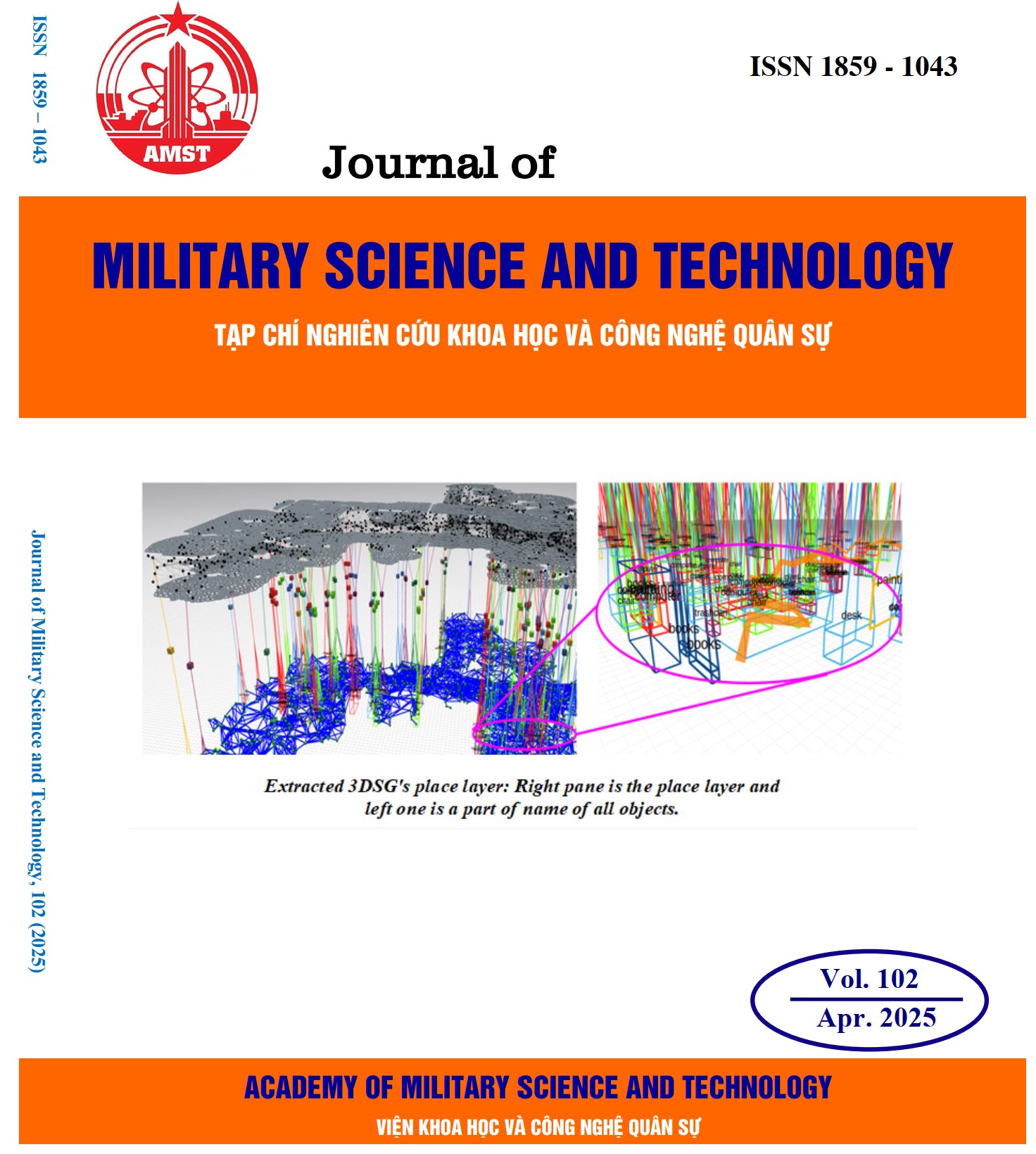Nghiên cứu quá trình hấp phụ methylene blue trên bề mặt than hoạt tính: Kết hợp nghiên cứu thực nghiệm và mô phỏng phân tử
376 lượt xemDOI:
https://doi.org/10.54939/1859-1043.j.mst.102.2025.84-93Từ khóa:
Than hoạt tính; Methylene blue; Mô phỏng phân tử.Tóm tắt
Nước thải có chứa methylene blue có trong nước thải dệt nhuộm nếu không được xử lý gây ô nhiễm nghiêm trong môi trường nước, phá hủy sinh thái và mang nhiều độc tính đói với sức khỏe con người. Bài báo này đã tiến hành nghiên cứu khả năng hấp phụ methylene blue của than hoạt tính trong nước. Mẫu than hoạt tính được tiền xử lý với các tỷ lệ KOH khác nhau cho dung lượng hấp phụ methylene blue cao nhất đạt được bằng 619,92 mg/g. Nghiên cứu đã tiến hành đánh giá quá trình hấp phụ bằng hệ thống các mô hình động học và đẳng nhiệt hấp phụ cho kết quả quá trình hấp phụ phù hợp nhất với mô hình động học bậc hai và mô hình đẳng nhiệt hấp phụ Langmuir với các hệ số phù hợp R2 đều ở mức cao. Nghiên cứu cũng tiến hành áp dụng các phương pháp mô phỏng phân tử nhằm làm rõ bản chất của quá trình hấp phụ. Kết quả chỉ ra rằng, cơ chế hấp phụ đa lớp với lực liên kết tĩnh điện đặc trưng cho khả năng tạo liên kết bền vững giữa bề mặt than hoạt tính và các phân tử methylene blue. Từ kết quả của nghiên cứu cho thấy hiệu quả xử lý ô nhiễm nguồn nước bởi methylene blue của than hoạt tính.
Tài liệu tham khảo
[1]. Oladoye P.O, Ajiboye T.O, Omotola E.O, and Oyewola O.J, "Methylene blue dye: Toxicity and potential elimination technology from wastewater", Results in Engineering, 16, p. 100678, (2022), https://doi.org/10.1016/j.rineng.2022.100678 DOI: https://doi.org/10.1016/j.rineng.2022.100678
[2]. Khan I, Saeed K, Zekker I, Zhang B, Hendi A.H, Ahmad A, Ahmad S, Zada N, Ahmad H, and Shah L.A, "Review on methylene blue: Its properties, uses, toxicity and photodegradation", Water, 14(2), p. 242, (2022), https://doi.org/10.3390/w14020242 DOI: https://doi.org/10.3390/w14020242
[3]. Moorthy A.K, Rathi B.G, Shukla S.P, Kumar K, and Bharti V.S, "Acute toxicity of textile dye Methylene blue on growth and metabolism of selected freshwater microalgae", Environmental Toxicology and Pharmacology, 82, p. 103552, (2021), https://doi.org/10.1016/j.etap.2020.103552 DOI: https://doi.org/10.1016/j.etap.2020.103552
[4]. Mashkoor F and Nasar A, "Magsorbents: Potential candidates in wastewater treatment technology–A review on the removal of methylene blue dye", Journal of magnetism magnetic materials, 500, p. 166408, (2020), https://doi.org/10.1016/j.jmmm.2020.166408 DOI: https://doi.org/10.1016/j.jmmm.2020.166408
[5]. Kuang Y, Zhang X, and Zhou S, "Adsorption of methylene blue in water onto activated carbon by surfactant modification", Water, 12(2), p. 587, (2020), https://doi.org/10.3390/w12020587 DOI: https://doi.org/10.3390/w12020587
[6]. Fito J, Abrham S, and Angassa K, "Adsorption of methylene blue from textile industrial wastewater onto activated carbon of Parthenium hysterophorus", International Journal of Environmental Research, 14, p. 501-511, (2020), https://doi.org/10.1007/s41742-020-00273-2 DOI: https://doi.org/10.1007/s41742-020-00273-2
[7]. El-Bery H.M, Saleh M, El-Gendy R.A, Saleh M.R, and Thabet S.M, "High adsorption capacity of phenol and methylene blue using activated carbon derived from lignocellulosic agriculture wastes", Scientific reports, 12(1), p. 5499, (2022), https://doi.org/10.1038/s41598-022-09475-4 DOI: https://doi.org/10.1038/s41598-022-09475-4
[8]. Jawad A.H, Abdulhameed A.S, Wilson L.D, Syed-Hassan S.S.A, ALOthman Z.A, and Khan M.R, "High surface area and mesoporous activated carbon from KOH-activated dragon fruit peels for methylene blue dye adsorption: optimization and mechanism study", Chinese Journal of Chemical Engineering, 32, p. 281-290, (2021), https://doi.org/10.1016/j.cjche.2020.09.070 DOI: https://doi.org/10.1016/j.cjche.2020.09.070
[9]. Khnifira M, El Hamidi S, Sadiq M, Şimşek S, Kaya S, Barka N, and Abdennouri M, "Adsorption mechanisms investigation of methylene blue on the (0 0 1) zeolite 4A surface in aqueous medium by computational approach and molecular dynamics", Applied Surface Science, 572, p. 151381, (2022), https://doi.org/10.1016/j.apsusc.2021.151381 DOI: https://doi.org/10.1016/j.apsusc.2021.151381
[10]. Guediri A, Bouguettoucha A, Chebli D, Chafai N, and Amrane A, "Molecular dynamic simulation and DFT computational studies on the adsorption performances of methylene blue in aqueous solutions by orange peel-modified phosphoric acid", Journal of Molecular Structure, 1202, p. 127290, (2020), https://doi.org/10.1016/j.molstruc.2019.127290 DOI: https://doi.org/10.1016/j.molstruc.2019.127290
[11]. Narayanaswamy V, Alaabed S, and Obaidat I.M, "Molecular simulation of adsorption of methylene blue and rhodamine B on graphene and graphene oxide for water purification", Materials Today: Proceedings, 28, p. 1078-1083, (2020), https://doi.org/10.1016/j.matpr.2020.01.086 DOI: https://doi.org/10.1016/j.matpr.2020.01.086
[12]. Surekha G, Krishnaiah K.V, Ravi N, and Suvarna R.P, FTIR, "Raman and XRD analysis of graphene oxide films prepared by modified Hummers method", in Journal of Physics: Conference Series, IOP Publishing, (2020), https://doi.org/10.1088/1742-6596/1495/1/012012 DOI: https://doi.org/10.1088/1742-6596/1495/1/012012
[13]. Yu L, Guo Y, Chen H, Liu B, Xu X, Sheng P, Zeng Z, and Li L, "Influence of functional groups and pore sizes in porous carbon for methanol acetone adsorptive separation based on molecular simulation", Journal of Materials Science, 56, p. 18550-18565, (2021), https://doi.org/10.1007/s10853-021-06549-y DOI: https://doi.org/10.1007/s10853-021-06549-y







